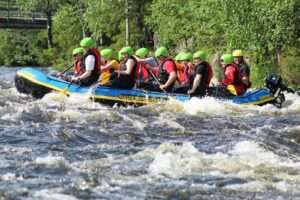In today’s fast-paced and increasingly digitized world, remote teams have become more common than ever before. However, managing a remote team can be challenging, especially when it comes to fostering collaboration and building a cohesive team dynamic. In this article, we’ll explore some of the most effective strategies for team building in a remote environment.
Table of Contents
The Art of Team Building: Strategies for Creating a Cohesive and Productive Remote Team
Prioritizing Communication and Trust

One of the most critical components of building a cohesive remote team is communication. Without clear and consistent communication, team members can feel disconnected and disengaged, leading to decreased productivity and morale. Here are some tips for prioritizing communication and trust:
- Use video conferencing software for team meetings and one-on-ones to foster a more personal connection between team members.
- Encourage regular check-ins and daily stand-up meetings to stay connected and keep everyone on the same page.
- Establish clear communication protocols, such as response times and communication channels, to avoid confusion and ensure everyone is on the same page.
- Develop trust by creating a culture of openness and transparency, where team members feel comfortable sharing their thoughts and ideas.
Building a Sense of Team Identity
One of the biggest challenges of remote work is the lack of a physical workplace, which can make it difficult to build a sense of team identity and culture. However, there are several strategies that can help create a strong team identity:
- Develop a team mission statement or manifesto that outlines your team’s values, goals, and purpose.
- Create a team logo or symbol that can be used on internal documents and communications to help foster a sense of identity.
- Establish team traditions and rituals, such as virtual happy hours or team lunches, to create a sense of community and camaraderie.
- Encourage team members to share their hobbies and interests outside of work to build connections beyond the virtual workplace.
Promoting Collaboration and Accountability

Effective collaboration is essential for remote teams, but it can be challenging when team members are working in different locations and time zones. Here are some tips for promoting collaboration and accountability:
- Use project management software, such as Asana or Trello, to keep track of tasks and deadlines and ensure everyone is on the same page.
- Encourage team members to collaborate on projects and share their ideas and expertise to improve the quality of work.
- Establish clear expectations and hold team members accountable for their work by setting clear deadlines and providing regular feedback.
- Celebrate team successes and recognize individual contributions to promote a sense of accomplishment and motivation.
In conclusion, building a cohesive and productive remote team requires a combination of effective communication, a strong team identity, and a culture of collaboration and accountability. By prioritizing these strategies, remote teams can overcome the challenges of distance and technology to create a dynamic and successful team dynamic.
10 Facts about Team Building

- Increased Productivity:
- Team building activities contribute to higher productivity as they help team members understand each other’s strengths and weaknesses.
- Improved Communication:
- Team building fosters better communication skills among team members, leading to more effective collaboration on tasks and projects.
- Enhanced Creativity:
- Collaborative activities encourage the sharing of ideas and perspectives, sparking creativity and innovation within the team.
- Boosted Morale:
- Engaging in team-building activities helps create a positive work environment, leading to increased morale and job satisfaction among team members.
- Conflict Resolution Skills:
- Team-building exercises often involve problem-solving scenarios, which help team members develop effective conflict resolution skills.
- Established Trust:
- Building trust is crucial for a successful team. Team-building activities create opportunities for team members to develop trust in each other’s abilities and intentions.
- Identifying Strengths and Weaknesses:
- Team-building exercises provide insights into individual strengths and weaknesses, allowing teams to allocate tasks more effectively based on each member’s capabilities.
- Improved Collaboration:
- Team building fosters a sense of collaboration and encourages team members to work together towards common goals, leading to better overall team performance.
- Enhanced Problem-Solving:
- Team-building activities often simulate real-world problem-solving scenarios, helping teams develop critical thinking skills and strategies to tackle challenges.
- Better Team Dynamics:
- Team building helps create strong bonds among team members, improving overall team dynamics and making it easier for the team to adapt to changes and overcome obstacles together.
Find out more about our experiences.
You may also want to check out our gallery for past events.




















